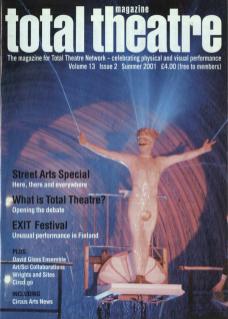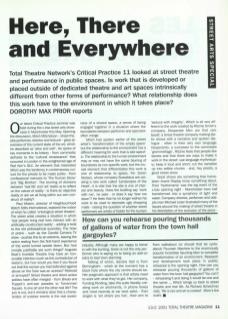Our latest Critical Practice seminar was held during the x.trax street arts show case in Manchester this May. Opening the discussion, Mitch Mitchelson – street theatre performer, director and lecturer – gave an overview of the current state of the art, which he described as 'alive and well’. He spoke of key moments in its history – from commedia dell'arte to the 'cultural renaissance' that occurred in London in the enlightened age of Red Ken's GLC. An element that interested Mitch was the tendency in contemporary culture for the private to be made public – from confessional memoirs to The Truman Show and Big Brother. The blurring of divisions between 'real life' and 'art' leads us to reflect on the nature of reality – is there an objective reality or are we all living within our own construct of reality?
Paul Miskin, director of Neighbourhood Watch Stilts International, explored the notion of what he called 'ontological street theatre'. The street artist creates a situation in which 'real people living real lives interact with an artificially constructed reality' – adding a twist to the old philosophical quandary. The hoax or prank – such as the Candid Camera TV show – pushes this to an extreme, leaving the victim reeling from the first-hand experience of the world turned upside down. But how morally justifiable are such things? Augusto Boal's Invisible Theatre may have an honourable intention (such as the contradiction of sexism), but how would you feel if you found out that the woman you had defended against abuse on the Tube was an actress? Relieved or annoyed? Street theatre and direct action politics have often merged – from Bread and Puppet's anti-war parades to Tiananmen Square. Is one art and the other real life? The jury is out, but it remains clear that a characteristic of outdoor events is the real awareness of a shared space, a sense of being engaged together in a situation where the boundaries between performer and spectator often merge.
Mitch had spoken earlier of the street artist's ‘transformation of the empty space' but the relationship to the environment has a different meaning for work that is site-specific. The relationship to the human environment may or may not have the same blurring of boundaries as non-specific work, but the crucial element that differentiates this work is one of relationship to space. For Soren Nielsen, whose company Scarabeus are creating a new work called Landscapes of the Heart, it is vital that the site is one of interest and beauty. Does the building say 'work with me', he asks – or does it say ‘tear me down'? He feels that he no longer wishes his work to be used to decorate ugly shopping malls – raising the question of whether street performers are artists or fodder for the tourism industry. Although many are happy to blend in with the bunting, Soren is not the only performer who is saying no to being an add-on extra to bad town planning.
Talking of which, Sandra Hall is from Birmingham – which at the moment has a black hole where the city centre should be. Her pragmatic approach is that artists need to work with what they've got. Her company, Funding Pending, take this quite literally; creating work on allotments, in phone boxes and most recently at car boot sales – their slogan is 'art where you live', their aim to 'seduce with integrity'. Which is all very different to the work created by Ritchie Smith's company. Desperate Men are that rare beast: a street theatre company making static shows with a narrative and spoken dialogue – often in their very own language: Desperanto, a successor to the commedia ‘grommeltage'. Ritchie feels that people like stories and that there are ways to make it work in the street: use language rhythmically; keep it loud and short; cut the narrative up into edible chunks – and, hey presto, a good street show.
How can you rehearse pouring thousands of gallons of water from the town hall gargoyles?
Good shows are something that home-team Avanti Display know something about. Their Hydromania was the big event of the x.trax opening night – Manchester town hall transformed into a symphony of light and water. Company director, performer and odd-job man Michael Lister illustrated many of the issues around the making of street theatre in his description of the evolution of the piece from walkabout (or should that be cycleabout) Fountain Machine to the enormously popular Incredible Spurting Man to complete transformation of an environment. Research and development took place in public; rehearsal is the opening night. How can you rehearse pouring thousands of gallons of water from the town hall gargoyles? You can't – rehearsing it and doing it would be one and the same... Which brings us back to street theatre and real life. As Richard Schechner said, 'life is raw and art is cooked'. Mine's the Sushi.

